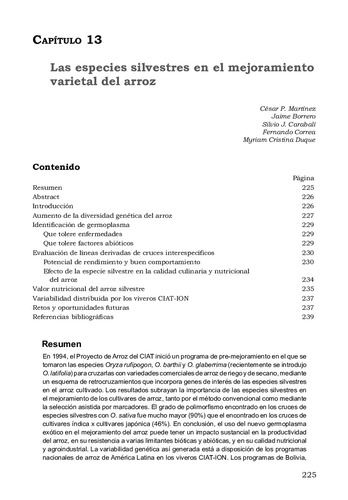Las especies silvestres en el mejoramiento varietal del arroz
Wild species in varietal improvement of rice In 1994 the CIAT Rice Project launched a pre-breeding program that crossed the species Oryza rufipogon, O. barthii, and O. glaberrima (O. latifolia was recently introduced) with commercial irrigated and upland rice varieties, using a backcrossing scheme that incorporates genes of interest of wild species into cultivated rice. The results emphasize the importance of wild species in improving rice cultivars using both conventional methods and marker-assisted selection. The degree of polymorphism found in crosses of wild species with O. sativa was much higher (90%) than that found in crosses of indica x japonica cultivars (46%). In conclusion, the use of new exotic germplasm in rice improvement can have a substantial impact on rice productivity, its resistance to several biotic and abiotic stresses, and its nutritional and agroindustrial quality. National rice programs of Latin America can access the genetic variability thus generated in the CIAT-ION nurseries. Programs in Bolivia, Panama, and Nicaragua, for example, identified several lines derived from crosses between O. sativa x O. glaberrima and between O. sativa x O. rufipogon that show good yield potential, tolerance to major pests and diseases, good-quality grain, and good adaptability. Some of these lines were launched as commercial varieties in 2009 and 2010.

